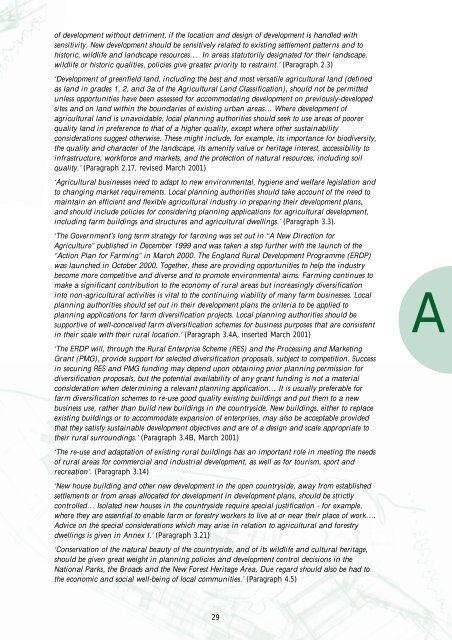A Farmer's Guide to the Planning System - ARCHIVE: Defra
A Farmer's Guide to the Planning System - ARCHIVE: Defra
A Farmer's Guide to the Planning System - ARCHIVE: Defra
Create successful ePaper yourself
Turn your PDF publications into a flip-book with our unique Google optimized e-Paper software.
of development without detriment, if <strong>the</strong> location and design of development is handled with<br />
sensitivity. New development should be sensitively related <strong>to</strong> existing settlement patterns and <strong>to</strong><br />
his<strong>to</strong>ric, wildlife and landscape resources… In areas statu<strong>to</strong>rily designated for <strong>the</strong>ir landscape,<br />
wildlife or his<strong>to</strong>ric qualities, policies give greater priority <strong>to</strong> restraint.’ (Paragraph 2.3)<br />
‘Development of greenfield land, including <strong>the</strong> best and most versatile agricultural land (defined<br />
as land in grades 1, 2, and 3a of <strong>the</strong> Agricultural Land Classification), should not be permitted<br />
unless opportunities have been assessed for accommodating development on previously-developed<br />
sites and on land within <strong>the</strong> boundaries of existing urban areas… Where development of<br />
agricultural land is unavoidable, local planning authorities should seek <strong>to</strong> use areas of poorer<br />
quality land in preference <strong>to</strong> that of a higher quality, except where o<strong>the</strong>r sustainability<br />
considerations suggest o<strong>the</strong>rwise. These might include, for example, its importance for biodiversity,<br />
<strong>the</strong> quality and character of <strong>the</strong> landscape, its amenity value or heritage interest, accessibility <strong>to</strong><br />
infrastructure, workforce and markets, and <strong>the</strong> protection of natural resources, including soil<br />
quality.’ (Paragraph 2.17, revised March 2001)<br />
‘Agricultural businesses need <strong>to</strong> adapt <strong>to</strong> new environmental, hygiene and welfare legislation and<br />
<strong>to</strong> changing market requirements. Local planning authorities should take account of <strong>the</strong> need <strong>to</strong><br />
maintain an efficient and flexible agricultural industry in preparing <strong>the</strong>ir development plans,<br />
and should include policies for considering planning applications for agricultural development,<br />
including farm buildings and structures and agricultural dwellings.’ (Paragraph 3.3).<br />
‘The Government’s long term strategy for farming was set out in “A New Direction for<br />
Agriculture” published in December 1999 and was taken a step fur<strong>the</strong>r with <strong>the</strong> launch of <strong>the</strong><br />
“Action Plan for Farming” in March 2000. The England Rural Development Programme (ERDP)<br />
was launched in Oc<strong>to</strong>ber 2000. Toge<strong>the</strong>r, <strong>the</strong>se are providing opportunities <strong>to</strong> help <strong>the</strong> industry<br />
become more competitive and diverse and <strong>to</strong> promote environmental aims. Farming continues <strong>to</strong><br />
make a significant contribution <strong>to</strong> <strong>the</strong> economy of rural areas but increasingly diversification<br />
in<strong>to</strong> non-agricultural activities is vital <strong>to</strong> <strong>the</strong> continuing viability of many farm businesses. Local<br />
planning authorities should set out in <strong>the</strong>ir development plans <strong>the</strong> criteria <strong>to</strong> be applied <strong>to</strong><br />
planning applications for farm diversification projects. Local planning authorities should be<br />
supportive of well-conceived farm diversification schemes for business purposes that are consistent<br />
in <strong>the</strong>ir scale with <strong>the</strong>ir rural location.’ (Paragraph 3.4A, inserted March 2001)<br />
‘The ERDP will, through <strong>the</strong> Rural Enterprise Scheme (RES) and <strong>the</strong> Processing and Marketing<br />
Grant (PMG), provide support for selected diversification proposals, subject <strong>to</strong> competition. Success<br />
in securing RES and PMG funding may depend upon obtaining prior planning permission for<br />
diversification proposals, but <strong>the</strong> potential availability of any grant funding is not a material<br />
consideration when determining a relevant planning application… It is usually preferable for<br />
farm diversification schemes <strong>to</strong> re-use good quality existing buildings and put <strong>the</strong>m <strong>to</strong> a new<br />
business use, ra<strong>the</strong>r than build new buildings in <strong>the</strong> countryside. New buildings, ei<strong>the</strong>r <strong>to</strong> replace<br />
existing buildings or <strong>to</strong> accommodate expansion of enterprises, may also be acceptable provided<br />
that <strong>the</strong>y satisfy sustainable development objectives and are of a design and scale appropriate <strong>to</strong><br />
<strong>the</strong>ir rural surroundings.’ (Paragraph 3.4B, March 2001)<br />
‘The re-use and adaptation of existing rural buildings has an important role in meeting <strong>the</strong> needs<br />
of rural areas for commercial and industrial development, as well as for <strong>to</strong>urism, sport and<br />
recreation’. (Paragraph 3.14)<br />
‘New house building and o<strong>the</strong>r new development in <strong>the</strong> open countryside, away from established<br />
settlements or from areas allocated for development in development plans, should be strictly<br />
controlled… Isolated new houses in <strong>the</strong> countryside require special justification - for example,<br />
where <strong>the</strong>y are essential <strong>to</strong> enable farm or forestry workers <strong>to</strong> live at or near <strong>the</strong>ir place of work….<br />
Advice on <strong>the</strong> special considerations which may arise in relation <strong>to</strong> agricultural and forestry<br />
dwellings is given in Annex I.’ (Paragraph 3.21)<br />
‘Conservation of <strong>the</strong> natural beauty of <strong>the</strong> countryside, and of its wildlife and cultural heritage,<br />
should be given great weight in planning policies and development control decisions in <strong>the</strong><br />
National Parks, <strong>the</strong> Broads and <strong>the</strong> New Forest Heritage Area. Due regard should also be had <strong>to</strong><br />
<strong>the</strong> economic and social well-being of local communities.’ (Paragraph 4.5)<br />
29<br />
A

















